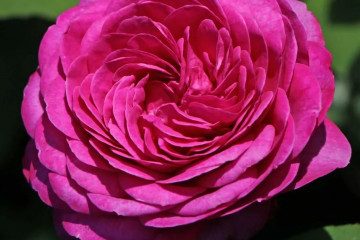Rose Patio - what is this variety
Content:
Dwarf rose varieties attract gardeners with their miniature beauty. Some small flowers are not dwarf, although they grow on average only 30-50 cm in height. Today we will focus on one of these varieties - in the center of attention of the Patio Mix rose.
Roses Patio: general information
Patio roses were brought to Europe in the 19th century from their homeland - China. Were crossed with floribunda roses. They are also called Miniflora, but this name did not take root in Europe. The mother plant is considered to be a hybrid tea rose.
The description as it stands says that Patio roses are a variety of low-growing spray roses of the Pink family of the floribunda group. The foliage is dense, dark green. They differ in their size - 70 cm in height, some specimens grow only 30-50 cm. During flowering, the bush is strewn with buds, which can be double or semi-double, grow in inflorescences or singly. Flowers have a pleasant aroma and varied colors of white, pink, red, yellow or orange tones.
Patios are grown in pots or planters for home decoration, and mixborders are also decorated with them.
Varieties of indoor plants
- Korsnoda
The bush is compact, the maximum size is 60 cm in height. Terry flowers, white and cream colors. Long and abundant flowering.
- Rose spray Macarena
The bush is compact, the inflorescences are large. The foliage is glossy. The blossoming flowers are rosette-shaped and light yellow with a brighter center. Over time, they acquire a pink tint.
- Pink Flash
Winter hardy look. The bush is 50-60 cm high. The peculiarity is the marble color. The flowers are pink, there are light pink stripes on the petals, which in the cold change color to a more intense pink.
- Typhoon
The bush is up to 70 cm. The flowers are small, the color is red with shades of orange. It is more often grown in pots than outdoors.
- Patio hit
Bushes are compact, 30-40 cm in height. Flowers are semi-double or double, lush, of different colors.
Rose Patio Hit, home care for which is not difficult, is perhaps the most popular type of Patio in Russia. Moreover, both experienced flower lovers and beginners try to grow it.
Patio roses: home care
Roses tolerate drought well. They need a lot of sun, but not in abundance. It is advisable that the rose is in the sun in the morning.
Water the plant as the soil dries up. It is advisable to do this rarely, but in large quantities.
The soil is desirable slightly acidic. Fertilizer is applied 3-4 times a year: in the spring - nitrogen, in the summer - phosphorus and potash.
The size of the pot depends on the variety. Basically, it is required that the container is 30-35 cm deep - this will be enough for the Patio.
Dried or broken stems are cut off, and the infected ones must also be removed. During flowering, it is necessary to cut off the faded buds.
In the first year, it is better not to let the plant bloom until it has matured and got used to the new conditions.
If a ready-made planted bush is purchased, it should be transplanted into a suitable container along with an earthen clod, trying not to injure the roots.
Planting a patio rose in open ground
The variety can be grown both in a pot on a windowsill and in the open field.
Landing on the site is carried out in the spring, when the weather is warm, favorable for the growth of the flower.
Seedlings choose strong ones - each should have several leaves and roots.
You can treat the seedling with a fungicide to prevent fungal diseases and stimulate growth.
Step-by-step landing instructions:
- Dig a hole 20-30 cm in diameter.
- At the bottom of the hole, humus scraps 10 cm are poured.
- When planting a seedling, gently straighten its roots and cover them with soil, lightly tamping them. The base of the stem after burying should go slightly into the ground.
- The planted seedling must be watered abundantly.
The place is chosen sunny, but not too much: roses love the sun, but its excess leads to burns. Attention is also drawn to drafts - they should not be.
The ideal soil is slightly acidic loam. If the soil is different, it must be improved - add clay and sand mixed in equal proportions.
Moderate watering is required. Lack of moisture leads to lethargy of the bush, an excess can provoke rotting of the roots. It is advisable to water the plant rarely, but abundantly, since the main roots of the plant go deep underground. The owner of a rose bush needs to be guided by the drying out of the soil.
Fertilizer is applied only in the second year of growth. In the spring, with active growth of leaves and the formation of buds, nitrogen fertilizers are suitable. But only in the spring - in the summer they use phosphorus and potash fertilizers. In total, feeding is carried out 3-4 times a year. For these purposes, complex mineral fertilizers from a store are suitable.
The plant is cut in the spring - broken and dry stems are removed. In the summer, dry twigs and faded buds are removed.
At the end of flowering, cut off all the stems - even those that did not bud. Before the cold weather, the bush is checked for infected parts: they are removed. The bush itself can be cut to the shape required for a comfortable shelter for the winter. Before frosts, the rose bush is covered with spruce branches.
How the patio rose blooms
The blooming of roses is always an event. Dwarf roses have their own characteristics during this period.
Rose Patio is distinguished by long-term profuse flowering - sometimes until frost. During flowering, flowers appear both singly and in inflorescences.
For roses, a dormant period is important for the plant to rest and recover. At this time, the leaves begin to turn yellow and growth slows down. If the plant is in a pot, it should be placed in a cooler place.
Patio rose buds resemble the flowers of the hybrid tea rose, which is considered the mother plant in this chain.
There are three types of flowers:
- simple;
- terry;
- semi-double.
The flowers are lush, the maximum diameter is 9 cm, they have a pleasant aroma.
Flower reproduction methods
The patio reproduces in two ways:
- cuttings;
- grafting of a shoot on a rose hip.
Propagation by cuttings
Cuttings are cut at any time of the year. It is believed that cuttings cut in summer take root best. If they are immediately planted in open ground, then before that they are placed in water until the first roots appear. If they are harvested on the eve of winter, then the cuttings are wrapped in peat and paper and stored in the refrigerator or cellar.
Reproduction by grafting a shoot on a rosehip
I advise you to take the rosehip variety that is frost-resistant, at least 3 years old.
Shoots 5 cm long are cut from the middle part of the rosebush. Important conditions are the presence of buds and a well-peeling bark.
The rootstock of a rose is a rosehip. The plant is dug up, the stems are shortened to 20 cm and stored in a cool place until spring. Before the procedure, he is examined for diseases. If there are any, the plant is treated with a solution of clay talker.
Vaccination can be carried out in the summer, but it is better in the spring. You will need a rose stalk and a rosehip stock, on which 2 oblique cuts are made. In this section, a rose stalk is fixed with a grafting tape or strips of fabric. The workpieces are placed in boxes.
For a quick result, boxes with blanks are placed in a room with high humidity and a temperature of 15-20 degrees. The sections will begin to heal in 2 weeks. 3 weeks after planting, the boxes are transferred to a warmer place. The stalk of the rose and the root of the rose hip completely grow together in 1-1.5 months. Then the fixing tapes are removed and the seedlings are planted in open ground.
Growing problems, diseases and pests
What diseases can attack roses?
- powdery mildew;
- rust;
- rot;
- leaf spot.
Pests can appear:
- spider mite;
- aphid;
- leaflet.
For prophylaxis in the spring, the plant is treated with fungicides or a solution of copper sulfate.
Already diseased or infected plants are treated with special preparations: Fitoverm, Karbofos, Hom, Topaz. Processing with wood ash or horsetail decoction is also possible.
Patio roses are not dwarf varieties, but with their miniature beauty they can decorate any garden as a reward for regular care. Flowers on the windowsill look especially beautiful, surprising bystanders. Taking care of the Patio is not too difficult, so lovers of indoor and garden plants should definitely pay attention to this variety.






















